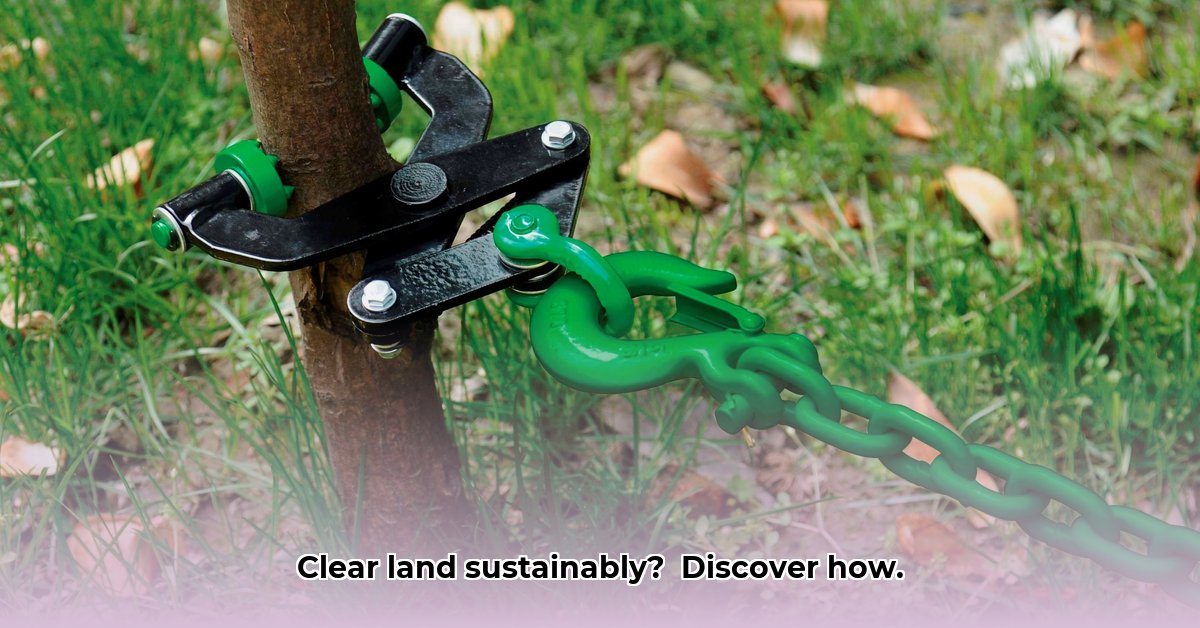
Brush grubbers, tractor-mounted implements designed for land clearing, offer a potentially efficient and cost-effective solution for sustainable land management. However, their effectiveness varies significantly depending on several factors, including soil type and vegetation density. This review provides a comprehensive guide to brush grubbers, exploring their advantages and limitations to help you determine if they are the right tool for your specific needs. For more information on tractor attachments, see this helpful resource.
How a Brush Grubber Works
A brush grubber consists of a sturdy metal frame with multiple, pointed tines (teeth) that aggressively tear through brush and small trees, pulling them out by their roots. The tractor's power provides the force needed for this process. These machines typically utilize heavy-duty steel construction for durability, making them capable of handling tough vegetation.
Advantages of Using a Brush Grubber
Brush grubbers deliver several key benefits:
- Increased Efficiency: Clearing land with a brush grubber is significantly faster than manual methods, saving considerable time and labor, especially beneficial for large-scale projects.
- Reduced Labor Costs: The reduced need for manual labor translates to lower labor costs, a significant advantage for smaller farms and businesses with tighter budgets.
- Invasive Species Control: They are particularly effective in controlling invasive plant species, helping restore native ecosystems and protect agricultural land.
Limitations of Using a Brush Grubber
Despite their advantages, brush grubbers have limitations:
- Soil Type Sensitivity: Their effectiveness is greatly influenced by soil type. Hard-packed clay or rocky soils significantly hinder their performance. Loose, well-drained soils are optimal.
- Vegetation Limitations: Brush grubbers are most effective on plants with shallow root systems. Deep-rooted plants, mature trees, or dense vegetation often require alternative methods.
- Potential for Soil Compaction: Overuse or improper operation can lead to soil compaction, negatively impacting soil health and future plant growth. This risk necessitates careful planning and execution. Careful consideration should be given to minimize soil disturbance and promote re-vegetation.
Sustainability Considerations
While brush grubbers offer efficiency gains, their environmental impact must be considered. The steel construction emphasizes durability, potentially reducing the frequency of replacements. However, the manufacturing process and eventual disposal should be thoughtfully assessed. Choosing manufacturers committed to sustainable practices, using recycled materials and efficient production, is crucial. Careful operation to minimize soil compaction and the implementation of restorative practices after land clearing are also essential for long-term sustainability.
Practical Applications and Best Practices
Effective and responsible brush grubber use involves several key steps:
- Pre-Operation Site Assessment: A comprehensive assessment of the soil type, vegetation density, and terrain is crucial before using a brush grubber. This helps determine its suitability for the specific task.
- Soil Condition Evaluation: Verify that the soil is appropriately loose and well-drained to avoid compaction and maximize efficiency. Avoid operation in overly wet or hard-packed soils.
- Appropriate Vegetation Selection: Focus on shallow-rooted vegetation. Avoid using it on larger trees or plants with deep roots.
- Maintenance and Safety: Regular maintenance, including sharpening the tines and inspecting for damage, is crucial for both efficiency and operator safety. Always follow the manufacturer’s safety guidelines.
Choosing the Right Brush Grubber
Several factors should guide your choice of brush grubber:
| Feature | Considerations |
|---|---|
| Tine Strength | Stronger tines are necessary for larger and more deeply rooted plants. Weaker tines might suffice for smaller vegetation. |
| Tractor Compatibility | Ensure compatibility with your tractor's horsepower and attachment capabilities. |
| Working Width | Select a width suitable for the area to be cleared. Smaller widths provide greater maneuverability in confined spaces. |
Minimizing Soil Compaction
Soil compaction is a primary concern when using brush grubbers. Strategies to mitigate this include:
- Pre-Operation Soil Moisture Check: Working when the soil is excessively wet dramatically increases compaction risk.
- Proper Ground Speed: Operate at a slow and deliberate speed to minimize soil disturbance.
- Use of Appropriate Brush Grubber: Select a model appropriate for the soil type and vegetation density.
- Planned Passes: Plan your work to minimize the repetition of passes over a single area.
- Post-Operation Assessment: Inspect for compaction signs and promptly address issues through aeration, organic matter addition, or cover cropping.
Conclusion
Brush grubbers offer a significant advantage in efficient land clearing, providing benefits in terms of speed, cost savings, and invasive species control. However, responsible use is paramount. Careful planning, appropriate tool selection, and consideration of soil conditions are essential to maximize benefits and minimize the potential for environmental impact. Sustainable land management requires a holistic approach that integrates brush grubbers with other techniques and considers the long-term health of the soil and ecosystem. Ongoing research and development in brush grubber technology are crucial to further improve their efficiency and minimize their environmental footprint.